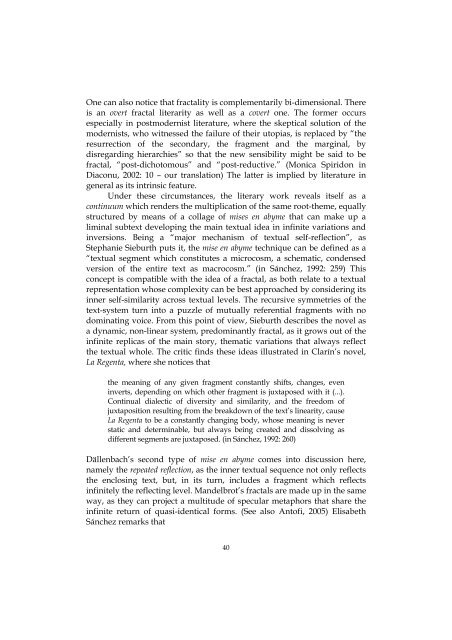translation studies. retrospective and prospective views
translation studies. retrospective and prospective views
translation studies. retrospective and prospective views
You also want an ePaper? Increase the reach of your titles
YUMPU automatically turns print PDFs into web optimized ePapers that Google loves.
One can also notice that fractality is complementarily bi-dimensional. There<br />
is an overt fractal literarity as well as a covert one. The former occurs<br />
especially in postmodernist literature, where the skeptical solution of the<br />
modernists, who witnessed the failure of their utopias, is replaced by “the<br />
resurrection of the secondary, the fragment <strong>and</strong> the marginal, by<br />
disregarding hierarchies” so that the new sensibility might be said to be<br />
fractal, “post-dichotomous” <strong>and</strong> “post-reductive.” (Monica Spiridon in<br />
Diaconu, 2002: 10 – our <strong>translation</strong>) The latter is implied by literature in<br />
general as its intrinsic feature.<br />
Under these circumstances, the literary work reveals itself as a<br />
continuum which renders the multiplication of the same root-theme, equally<br />
structured by means of a collage of mises en abyme that can make up a<br />
liminal subtext developing the main textual idea in infinite variations <strong>and</strong><br />
inversions. Being a “major mechanism of textual self-reflection”, as<br />
Stephanie Sieburth puts it, the mise en abyme technique can be defined as a<br />
“textual segment which constitutes a microcosm, a schematic, condensed<br />
version of the entire text as macrocosm.” (in Sánchez, 1992: 259) This<br />
concept is compatible with the idea of a fractal, as both relate to a textual<br />
representation whose complexity can be best approached by considering its<br />
inner self-similarity across textual levels. The recursive symmetries of the<br />
text-system turn into a puzzle of mutually referential fragments with no<br />
dominating voice. From this point of view, Sieburth describes the novel as<br />
a dynamic, non-linear system, predominantly fractal, as it grows out of the<br />
infinite replicas of the main story, thematic variations that always reflect<br />
the textual whole. The critic finds these ideas illustrated in Clarín’s novel,<br />
La Regenta, where she notices that<br />
the meaning of any given fragment constantly shifts, changes, even<br />
inverts, depending on which other fragment is juxtaposed with it (...).<br />
Continual dialectic of diversity <strong>and</strong> similarity, <strong>and</strong> the freedom of<br />
juxtaposition resulting from the breakdown of the text’s linearity, cause<br />
La Regenta to be a constantly changing body, whose meaning is never<br />
static <strong>and</strong> determinable, but always being created <strong>and</strong> dissolving as<br />
different segments are juxtaposed. (in Sánchez, 1992: 260)<br />
Dällenbach’s second type of mise en abyme comes into discussion here,<br />
namely the repeated reflection, as the inner textual sequence not only reflects<br />
the enclosing text, but, in its turn, includes a fragment which reflects<br />
infinitely the reflecting level. M<strong>and</strong>elbrot’s fractals are made up in the same<br />
way, as they can project a multitude of specular metaphors that share the<br />
infinite return of quasi-identical forms. (See also Antofi, 2005) Elisabeth<br />
Sánchez remarks that<br />
40












